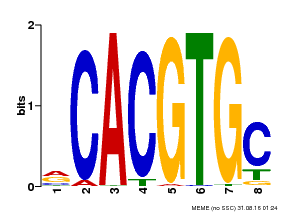- Riechmann JL, et al.
Arabidopsis transcription factors: genome-wide comparative analysis among eukaryotes.
Science, 2000. 290(5499): p. 2105-10
[PMID:11118137] - Abe H, et al.
Arabidopsis AtMYC2 (bHLH) and AtMYB2 (MYB) function as transcriptional activators in abscisic acid signaling.
Plant Cell, 2003. 15(1): p. 63-78
[PMID:12509522] - Heim MA, et al.
The basic helix-loop-helix transcription factor family in plants: a genome-wide study of protein structure and functional diversity.
Mol. Biol. Evol., 2003. 20(5): p. 735-47
[PMID:12679534] - Toledo-Ortiz G,Huq E,Quail PH
The Arabidopsis basic/helix-loop-helix transcription factor family.
Plant Cell, 2003. 15(8): p. 1749-70
[PMID:12897250] - Bailey PC, et al.
Update on the basic helix-loop-helix transcription factor gene family in Arabidopsis thaliana.
Plant Cell, 2003. 15(11): p. 2497-502
[PMID:14600211] - Lorenzo O,Chico JM,S
JASMONATE-INSENSITIVE1 encodes a MYC transcription factor essential to discriminate between different jasmonate-regulated defense responses in Arabidopsis.
Plant Cell, 2004. 16(7): p. 1938-50
[PMID:15208388] - Nagata T,Yamada H,Du Z,Todoriki S,Kikuchi S
Microarray analysis of genes that respond to gamma-irradiation in Arabidopsis.
J. Agric. Food Chem., 2005. 53(4): p. 1022-30
[PMID:15713015] - Devoto A, et al.
Expression profiling reveals COI1 to be a key regulator of genes involved in wound- and methyl jasmonate-induced secondary metabolism, defence, and hormone interactions.
Plant Mol. Biol., 2005. 58(4): p. 497-513
[PMID:16021335] - Hanada K, et al.
Functional compensation of primary and secondary metabolites by duplicate genes in Arabidopsis thaliana.
Mol. Biol. Evol., 2011. 28(1): p. 377-82
[PMID:20736450] - Niu Y,Figueroa P,Browse J
Characterization of JAZ-interacting bHLH transcription factors that regulate jasmonate responses in Arabidopsis.
J. Exp. Bot., 2011. 62(6): p. 2143-54
[PMID:21321051] - Fern
The Arabidopsis bHLH transcription factors MYC3 and MYC4 are targets of JAZ repressors and act additively with MYC2 in the activation of jasmonate responses.
Plant Cell, 2011. 23(2): p. 701-15
[PMID:21335373] - Tominaga-Wada R,Iwata M,Nukumizu Y,Wada T
Analysis of IIId, IIIe and IVa group basic-helix-loop-helix proteins expressed in Arabidopsis root epidermis.
Plant Sci., 2011. 181(4): p. 471-8
[PMID:21889054] - Figueroa P,Browse J
The Arabidopsis JAZ2 promoter contains a G-Box and thymidine-rich module that are necessary and sufficient for jasmonate-dependent activation by MYC transcription factors and repression by JAZ proteins.
Plant Cell Physiol., 2012. 53(2): p. 330-43
[PMID:22173100]
MEDIATOR25 acts as an integrative hub for the regulation of jasmonate-responsive gene expression in Arabidopsis.
Plant Physiol., 2012. 160(1): p. 541-55
[PMID:22822211]- Kazan K,Manners JM
MYC2: the master in action.
Mol Plant, 2013. 6(3): p. 686-703
[PMID:23142764] - Moreno JE, et al.
Negative feedback control of jasmonate signaling by an alternative splice variant of JAZ10.
Plant Physiol., 2013. 162(2): p. 1006-17
[PMID:23632853] - Schweizer F, et al.
Arabidopsis basic helix-loop-helix transcription factors MYC2, MYC3, and MYC4 regulate glucosinolate biosynthesis, insect performance, and feeding behavior.
Plant Cell, 2013. 25(8): p. 3117-32
[PMID:23943862] - Ding Y, et al.
Four distinct types of dehydration stress memory genes in Arabidopsis thaliana.
BMC Plant Biol., 2013. 13: p. 229
[PMID:24377444] - Song S, et al.
Interaction between MYC2 and ETHYLENE INSENSITIVE3 modulates antagonism between jasmonate and ethylene signaling in Arabidopsis.
Plant Cell, 2014. 26(1): p. 263-79
[PMID:24399301] - Chico JM, et al.
Repression of Jasmonate-Dependent Defenses by Shade Involves Differential Regulation of Protein Stability of MYC Transcription Factors and Their JAZ Repressors in Arabidopsis.
Plant Cell, 2014. 26(5): p. 1967-1980
[PMID:24824488] - Frerigmann H,Berger B,Gigolashvili T
bHLH05 is an interaction partner of MYB51 and a novel regulator of glucosinolate biosynthesis in Arabidopsis.
Plant Physiol., 2014. 166(1): p. 349-69
[PMID:25049362] - Qi T,Huang H,Song S,Xie D
Regulation of Jasmonate-Mediated Stamen Development and Seed Production by a bHLH-MYB Complex in Arabidopsis.
Plant Cell, 2015. 27(6): p. 1620-33
[PMID:26002869] - Gasperini D, et al.
Multilayered Organization of Jasmonate Signalling in the Regulation of Root Growth.
PLoS Genet., 2015. 11(6): p. e1005300
[PMID:26070206] - Qi T, et al.
Regulation of Jasmonate-Induced Leaf Senescence by Antagonism between bHLH Subgroup IIIe and IIId Factors in Arabidopsis.
Plant Cell, 2015. 27(6): p. 1634-49
[PMID:26071420] - Pauwels L, et al.
The RING E3 Ligase KEEP ON GOING Modulates JASMONATE ZIM-DOMAIN12 Stability.
Plant Physiol., 2015. 169(2): p. 1405-17
[PMID:26320228] - de Torres Zabala M, et al.
Novel JAZ co-operativity and unexpected JA dynamics underpin Arabidopsis defence responses to Pseudomonas syringae infection.
New Phytol., 2016. 209(3): p. 1120-34
[PMID:26428397] - Yu J, et al.
JAZ7 negatively regulates dark-induced leaf senescence in Arabidopsis.
J. Exp. Bot., 2016. 67(3): p. 751-62
[PMID:26547795] - Chen X,Huang H,Qi T,Liu B,Song S
New perspective of the bHLH-MYB complex in jasmonate-regulated plant fertility in arabidopsis.
Plant Signal Behav, 2016. 11(2): p. e1135280
[PMID:26829586] - Schmiesing A,Emonet A,Gouhier-Darimont C,Reymond P
Arabidopsis MYC Transcription Factors Are the Target of Hormonal Salicylic Acid/Jasmonic Acid Cross Talk in Response to Pieris brassicae Egg Extract.
Plant Physiol., 2016. 170(4): p. 2432-43
[PMID:26884488] - Thatcher LF, et al.
Characterization of a JAZ7 activation-tagged Arabidopsis mutant with increased susceptibility to the fungal pathogen Fusarium oxysporum.
J. Exp. Bot., 2016. 67(8): p. 2367-86
[PMID:26896849] - Gao C, et al.
MYC2, MYC3, and MYC4 function redundantly in seed storage protein accumulation in Arabidopsis.
Plant Physiol. Biochem., 2016. 108: p. 63-70
[PMID:27415132] - Gimenez-Ibanez S, et al.
JAZ2 controls stomata dynamics during bacterial invasion.
New Phytol., 2017. 213(3): p. 1378-1392
[PMID:28005270] - Lian TF,Xu YP,Li LF,Su XD
Crystal Structure of Tetrameric Arabidopsis MYC2 Reveals the Mechanism of Enhanced Interaction with DNA.
Cell Rep, 2017. 19(7): p. 1334-1342
[PMID:28514654] - Wang H, et al.
The bHLH Transcription Factors MYC2, MYC3, and MYC4 Are Required for Jasmonate-Mediated Inhibition of Flowering in Arabidopsis.
Mol Plant, 2017. 10(11): p. 1461-1464
[PMID:28827172] - Song S, et al.
MYC5 is Involved in Jasmonate-Regulated Plant Growth, Leaf Senescence and Defense Responses.
Plant Cell Physiol., 2017. 58(10): p. 1752-1763
[PMID:29017003] - Li B, et al.
Network-Guided Discovery of Extensive Epistasis between Transcription Factors Involved in Aliphatic Glucosinolate Biosynthesis.
Plant Cell, 2018. 30(1): p. 178-195
[PMID:29317470] - Han X, et al.
Jasmonate Negatively Regulates Stomatal Development in Arabidopsis Cotyledons.
Plant Physiol., 2018. 176(4): p. 2871-2885
[PMID:29496884]
|





